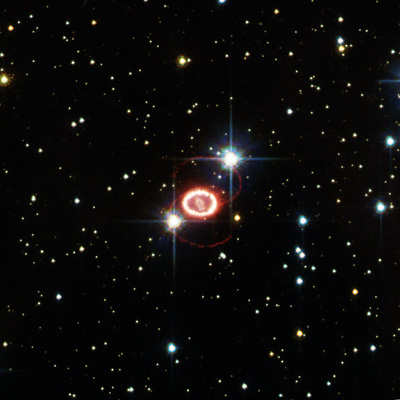

| Visitors Now: | |
| Total Visits: | |
| Total Stories: |

| Story Views | |
| Now: | |
| Last Hour: | |
| Last 24 Hours: | |
| Total: | |
Radioactive Decay Of Titanium Powers Supernova Remnant

Credits: ESA/Hubble & NASA
Dominating this Hubble Space Telescope view of the remnant are two glowing loops and a very bright ring of shocked hotspots surrounding the location of the now-exploded central star. The material making up these loops and rings was probably ejected from the star earlier in its history and is now being illuminated by the supernova and its shockwave.
The titanium-44 detected by Integral is powering only the innermost part of the remnant.
Astronomers expect a neutron star to have been left after the explosion, but no definitive evidence for it has yet been found.
After the collapse, the star rebounds and a spectacular supernova explosion results, with these constituent elements flung into space.
Supernovae can shine as brightly as entire galaxies for a very brief time thanks to the enormous amount of energy released in the explosion.
After the initial flash has faded, the total luminosity of the remnant is provided by the release of energy from the natural decay of radioactive elements produced in the explosion.
Each element emits energy at some characteristic wavelengths as it decays, providing insight into the chemical composition of the supernova ejecta – the shells of material flung out by the exploding star.
The first detection of titanium-44 in supernova remnant 1987A. ESA’s Integral space telescope made the detection in the energy range between 65 keV and 82 keV, which brackets two emission lines produced during the decay of titanium-44, at 67.9 keV and 78.4 keV.
The detection required over 1000 hours of observation time with Integral.
Also seen in the field of view are two other bright sources of high-energy emission, the black hole binary known as LMC X-1 and the pulsar PSR B0540-69.

Credits: ESA/Integral/IBIS–ISGRI/S. Grebenev et al.
During the peak of the explosion, fingerprints of elements from oxygen to calcium were detected, representing the outer layers of the ejecta.
Soon after, signatures of the material synthesised in the inner layers could be seen in the radioactive decay of nickel-56 to cobalt-56, and its subsequent decay to iron-56.
Now, thanks to more than 1000 hours of observation by Integral, high-energy X-rays from radioactive titanium-44 in supernova remnant 1987A have been detected for the first time.
“This is the first firm evidence of titanium-44 production in supernova 1987A and in an amount sufficient to have powered the remnant over the last 20 years,” says Sergei Grebenev from the Space Research Institute of the Russian Academy of Science in Moscow, and the first author of the paper reporting the results in Nature.
From their analysis of the data, the astronomers estimated that the total mass of titanium-44 that must have been produced just after the core collapse of SN1987A’s progenitor star amounted to 0.03% of the mass of our own Sun.
This image shows the patch of the sky surrounding the remnant of supernova remnant 1987A as seen in three different bands at high X-ray energies with ESA’s Integral. Titanium-44 is only present in the central image, which spans the 65–82 keV energy range. The panel on the left is based on data collected in the 48–65 keV band, whereas the panel on the right is based on data collected in the 82–99 keV band. The presence of signal corresponding to the position in the sky of SNR 1987A only in the energy range between 65 keV and 82 keV demonstrates that the signal does arise from emission at the specific wavelengths unique to the radioactive decay of Ti-44, at 67.9 keV and 78.4 keV.
Also seen in the field of view are two other bright sources of high-energy emission, the black hole binary known as LMC X-1 and the pulsar PSR B0540-69.

Credits: ESA/Integral/IBIS–ISGRI/S. Grebenev et al.
This value is near the upper boundary of theoretical predictions and is nearly twice the amount seen in supernova remnant Cas A, the only other remnant where titanium-44 has been detected.
“The high values of titanium-44 measured in Cas A and SNR1987A are likely produced in exceptional cases, favouring supernovae with an asymmetric geometry, and perhaps at the expense of the synthesis of heavier elements,” says Dr Grebenev.
“This is a unique scientific result obtained by Integral that represents a new constraint to be taken into account in future simulations for supernova explosions,” adds Chris Winkler, ESA’s Integral project scientist and co-author of the Nature paper.
“These observations are broadening our understanding of the processes involved during final stages of a massive star’s life.”
What’s Causing Turmoil On Jupiter, Planetary Changes, Bombardments
Where The Moon Really Came From
Sharpest View Ever Of Uranus And Its Weather
Earth Climate Models Works On Mars
Antarctica Grabs World’s Attention With Giant Rift And Maximum Ice
UFO Sighting Photos Leaked Out Of NASA-Johnson Space Center, 100% Clear UFOs In High Detail
Life Discovered On Mars By NASA Opportunity Rover, See Photos Close Up.
Gluten And Lactose-Free Ingredient Substitute Found For Low-Fat White Sauces


